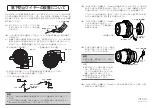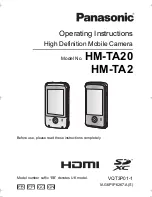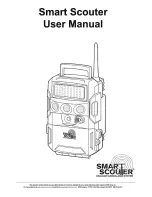
CT1-7541-004
© CANON INC. 1987
2008.5
●
❻
●
❼
6. Infrared Index
The infrared index corrects the focus setting when using
monochrome infrared film.
Focus on the subject in MF, then adjust the distance setting by
moving the focusing ring to the corresponding infrared index mark
❻
,
❼
.
• The infrared index position is based on a wavelength of 800 nm.
• Be sure to observe the manufacturer’s instructions when using
infrared film.
• Use a red filter also when you take the picture.
7. Filters (Sold Separately)
You can attach filters to the filter mounting thread on the front of
the lens.
• Use a polarizing Canon filter (52 mm).
8. Getting Better Results with Soft Focus
(1) Lighting
In general, soft focus gives better results in backlit or semi-backlit
shots. It is also a good idea to use a lens hood to avoid unwanted
effects from extraneous light in the shot.
(2) Subject foreground and background
In normal soft focus shots, you get a better result if you select
something relatively dark as the background for your subject.
Also, shot compositions that involve defocusing the foreground
are not a good idea as the defocusing effect is poor.
(3) Shooting distance
This lens gives its best soft focus effect at distances between 3
and 5 meters.
(4) Exposure
In general, exposures that are slightly higher than the correct
exposure produce a better soft-focus effect.
9. Specifications
Focal Length/Aperture
135 mm, f/2.8
Lens Construction
6 groups, 7 elements
Minimum Aperture
f/32
Angle of View
Diagonal
18°
Vertical
10°
Horizontal
15°
Min. Focusing Distance
1.3 m (4.3 ft.)
Max. Magnification
0.12×
Field of View
188 × 282 mm (7.4 ×11.1 inch)
Filter Diameter
52 mm
Max. Diameter and Length
69.2 × 98.4 mm (2.8 × 3.9 inch)
Weight
390 g (13.6 oz.)
Hood
ET-65III
Lens Cap
E-52
Case
LP1016
Q
The lens length is measured from the mount surface to the front
end of the lens. Add 21.5 mm when including the lens cap and
dust cap.
Q
The size and weight listed are for the lens only, except as
indicated.
Q
Aperture settings are specified on the camera.
Q
All data listed is measured according to Canon standards.
Q
Product specifications and appearance are subject to change
without notice.
This device complies with Part 15 of the FCC Rules. Operation
is subject to the following two conditions: (1) This device may
not cause harmful interference, and (2) this device must accept
any interference received, including interference that may cause
undesired operation.
Do not make any changes or modifications to the equipment
unless otherwise specified in the instructions. If such changes
or modifications should be made, you could be required to stop
operation of the equipment.
This equipment has been tested and found to comply with the
limits for a class B digital device, pursuant to part 15 of the FCC
Rules.
These limits are designed to provide reasonable protection against
harmful interference in a residential installation. This equipment
generates, uses and can radiate radio frequency energy and, if
not installed and used in accordance with the instructions, may
cause harmful interference to radio communications.
However, there is no guarantee that interference will not occur
in a particular installation. If this equipment does cause harmful
interference to radio or television reception, which can be
determined by turning the equipment off and on, the user is
encouraged to try to correct the interference by one or more of the
following measures:
• Reorient or relocate the receiving antenna.
• Increase the separation between the equipment and receiver.
• Consult the dealer or an experienced radio/TV technician for
help.
This Class B digital apparatus complies with Canadian ICES-003.
COP
Y




















